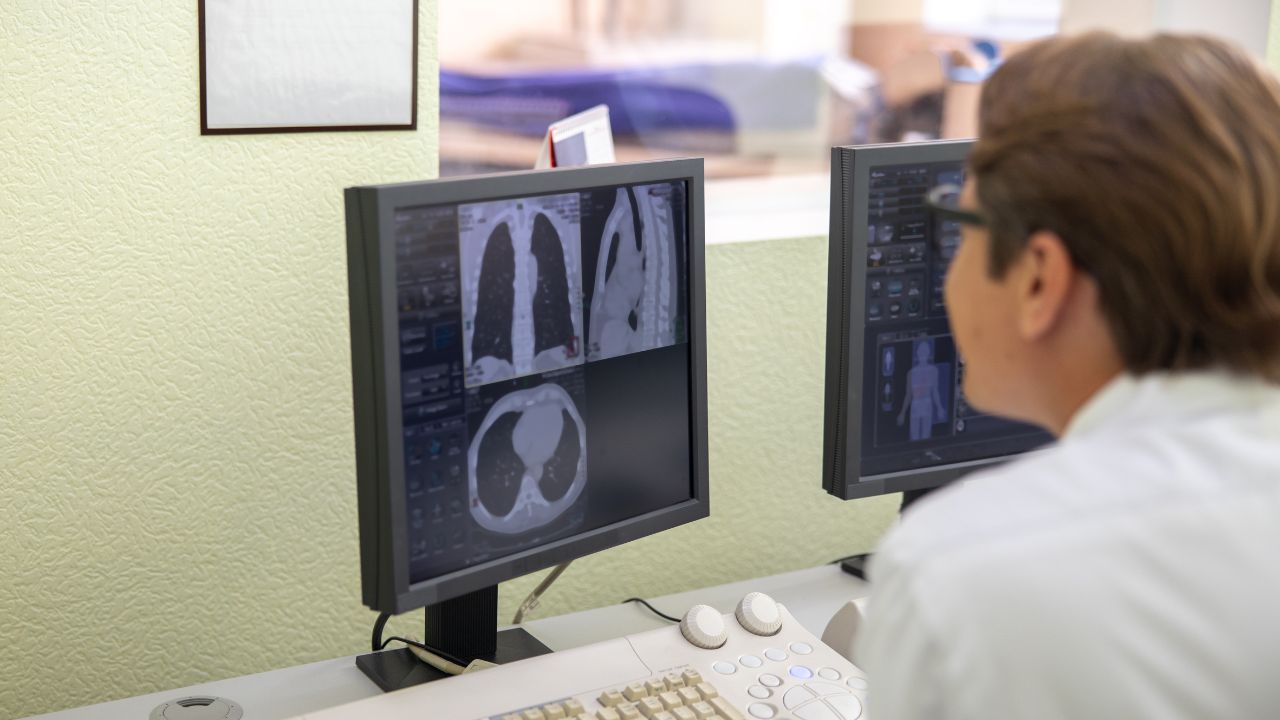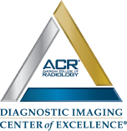
Computed Tomography (CT or CAT) Scan of the Chest
Chest CT Scan
Computer tomography, also referred to as a CAT scan or CT scan is a non-invasive imaging diagnostic procedure, which uses computer technology and X-rays to produce axial or horizontal images (also called slices) of the human body. The CAT scan essentially shows detailed images of the part of the body in question, including muscles, bones, organs, and fats. CT scans are in essence more detailed than the standard X-rays.
For standard x-rays, an energy beam is aimed to the part of the body being studies. A plate, usually placed behind the body, captures the variations of the beam as it passes through the skin, tissue, bone, or muscle. However, though you can get a lot of information about the internal organs and structures on a standard X-ray, a lot of detail is not availed.
The CT scan has the X-ray moving in a circle around the body. What this does is allow for many different views of the same structure or organ. Then, the information is sent to the computer, which will interpret the data and display the result on a 2-dimensional format on a computer monitor.
In essence, CT scans can be done with or without contrast – the substance taken orally or injected into an intravenous (IV) channel to help the particular part, tissue, or organ become more visible under the beams. In this case, contrast examinations often need you to keep away from taking food orally for a period of time before the procedure is done. Your doctor should notify you about this in due time.
Chest CT scans can offer a much-detailed information about the various structures and organs located inside the chest region, than standard X-rays would. Therefore, this is a more effective diagnostic procedure as it provides more information when it comes to injuries and diseases that are related to the thoracic (chest) organs.
CT scans on the chest can also be used to see the placement of needles in biopsy procedures for thoracic tumors or organs or during the withdrawal (aspiration) of fluid from the thoracic cavities. Such scans are essential for monitoring tumors as well as other conditions of the chest area before, during, and after treatment.
Reasons for CT scan of the Chest
The chest region contains vital organs of the cardiovascular and respiratory systems, plus the esophagus, which includes the hollow tube of muscle that extends from below the tongue to the stomach. For this reason, a chest CT scan can be used to assess the chest and the organs of the chest for tumors and other injuries, lesions, infections, bleeding, obstructions, unexplained chest pains, intrathoracic bleeding, as well as many other conditions, especially when the other forms of diagnosis and examination have proved ineffective (such as physical examinations and standard x-rays).
The CT scan performed of the chest can also be used for evaluating the effect of the various forms of treatment for thoracic tumors. Another use is offering guidance for biopsies or aspiration of the tissues located in the chest. Keep in mind that the doctor can recommend a CT scan for a variety of reasons, and it is best to trust his expertise.
Risk involved in CT scans
It is a good idea to ask your doctor amount of radiation that they use during the CT scan procedure as well as the risks involved when it comes to your particular situation. You may also want to keep an updated record of the previous history of exposure to radiation, including other previous CT scans, and other forms of x-rays so that you can inform your doctor before the procedure commences. The risks associated with radiation exposure are usually related to the cumulative amount of x-ray examinations and treatments over a period of time.
If you are actually pregnant, or you suspect that you are pregnant, it’s always good to inform your doctor. Exposing your body to radiation during pregnancy poses a risk for birth defects. When a contrast is used during the procedure, there is a risk for developing allergic reactions. In this case, let your doctor know if you have had an allergic reaction to any of the contrast media or any form of kidney problems. Reported seafood allergies are not considered contradictions to the iodinated contrast.
For patients with any form of kidney failure or kidney problems, be sure to notify the doctor. The reason for this is that sometimes the contrast media might cause kidney failure, especially for patients that are dehydrated or have underlying kidney problems. Patients who are currently under the diabetes prescription called Metformin (Glucophage) or any of its derivatives, some forms of contrast poses a risk of a condition referred to as metabolic acidosis, which is a dangerous change to the blood pH.
There are several other risks that may arise depending on the particular state of your health. In this case, be sure to have a talk with your doctor and discuss all the concerns that you might have prior to the CT scan procedure.
Other conditions or factors might interfere with the accuracy of chest CT scans.
Such factors include the following:
- Body Piercings on the chest
- Metallic objects placed within the chest like a pacemaker and surgical clips
- Barium in the esophagus from a recent barium examination
Preparation for a CT scan
Patients who are yet to undergo a computed tomography angiography (CTA) scan are given a basic set of instructions when they make the appointment.
Precautions
Should you be pregnant or suspect that you might be pregnant, please consult your doctor before you schedule your scan. Other options available for you will be discussed between you and your doctor.
Clothing
For clothing, keep in mind that you might be asked to change into an official patient gown. If this is the case, a gown will be provided to you. In addition, a locker will be assigned to ensure that your personal belongings are secured. Be sure to remove any form of piercings and leave all your valuables and jewelry at home.
Contrast Media
Most CT scans are usually done without a contrast media. The role of a contrast media is to improve the ability of the radiologist to view the images of the internal organs of the body.
Allergies
Make sure you inform the access center representatives if you have previously had any allergic reactions to contrast media, when you schedule the CT scan. Contrast IV will may not be administered to you if you have had an anaphylactic reaction in the past to any contrast media. If your allergy was mild and moderate during the previous use of contrast, then some medication will be administered prior to the chest CT scan. All of these plans will have to be discussed to you in detail in your appointment with our doctors for the exam. However, any known reactions to contrast media must be reported and discussed with your personal physician.
Food
You can eat and drink normally and even take your prescribed medications if your doctor decided to go with a CT scan without contrast. However, if your doctor ordered a CT scan with contrast, you will be told of restrictions prior to CT scan. Only clear liquids should be taken, and you may still take your prescribed medicine prior to the scan.
Diabetics
If you are a diabetic, you should eat a light meal three hours prior to the exam’s scheduled time. You might be asked to pause the use of medication for 48 hours after the scan, depending on the type of medication you use. You will be given detailed information on how to go about this, following your exam.
Medications
All patients may take the various forms of prescribed medicine as usual.
Don’t forget that based on your medical condition, the doctor might request a more specific preparation, which will be availed to you in detail.
CT scan Details: Procedure
CT scans can be performed on an outpatient basis and even as part of your stay in the hospital’s premises. The procedure will vary depending on the condition as well as the preferential aspects of your physician.
You might be asked to change into the patients’ gown, and this will be offered to you. In addition, a secure locker will be assigned to you where you can keep all of your personal items. Again, be sure to remove any forms of piercings and leave any valuables such as jewelry at home.
If your procedure involves the use of contrast, an intravenous (IV) line I started in the arm or hand for injection of the media. For the orally administered contrast, you will essentially be given a specially prepared liquid contrast preparation that you need to swallow. In some cases, the contrast can be given rectally.
Next, you will lie on the scan table, which slides into the large circular opening of the CT scanning machine. For comfort and preventing movement during the procedure, pillows and straps might be used. A technologist will be in the other room where the controls for the scanner are located. Nonetheless, you will be in a constant sight of the technologist via a window. You can communicate with the technologist via the speakers located inside the scanner. You also have a call button at your comfort to let them know if you are experiencing any problems as the procedure occurs. The technologist should be in constant communication with you, as they watch you every step of the procedure.
While the scanner starts to rotate around you, x-ray beams will be passing through the body for some amount of time. There are clicking sounds, which are very normal. The rays absorbed by your body tissue can be detected by the machine, and will be transmitted to the computer. This data will be translated into an image, and the radiologist can interpret it. More importantly, be sure to remain still throughout the procedure. You may also be asked to hold your breath several times during the procedure.
Contrast media may make you feel some effects when it is injected into the (IV) line. Such effects include a salty and metallic taste in your mouth, a flushing sensation, nausea or even vomiting, and a brief headache. The effects usually last for a short amount of time. Alert the technologist should you feel any form of breathing difficulties, numbness, sweating, or heart palpitations during the procedure.
Although the CT scan is not painful, the need to lie still for the entire procedure can be uncomfortable and even cause some pain, especially if you previously had an invasive procedure such as surgery or even an injury. In this case, the technologist will use all comfort measures possible and complete the procedure as quick as possible to minimize pain or discomfort.
Services
Contact Details
Address: 1971 Gowdey Road,
Naperville, IL 60563
Phone: 630-416-1300
Fax:
630-416-1511
Email: info@foxvalleyimaging.com
© Copyright 2023 Fox Valley Imaging, Inc..

